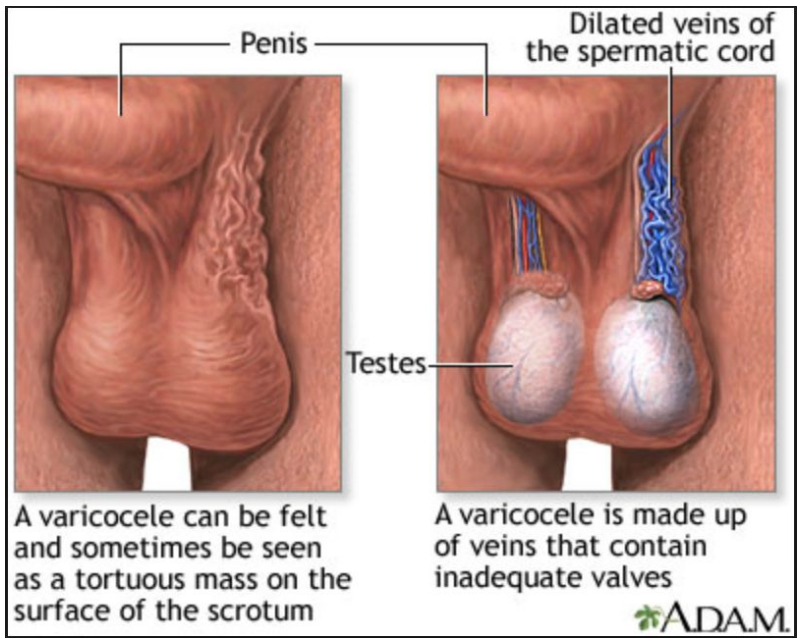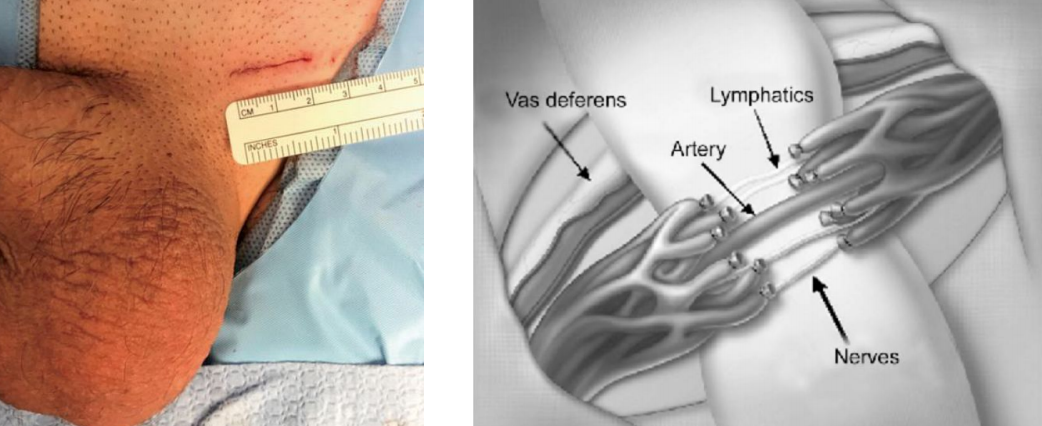What is a varicocele?
A varicocele is an enlarged system of veins, called the pampeniform plexus, within the scrotum. These are similar to varicose veins in the leg. The pampeniform plexus is a coiled system of veins that wrap around the other blood vessels that carry blood to and from the testicle. The purpose of this venous system is to keep the temperature inside the testicle cooler than the surrounding body temperature. A cooler environment allows for optimal function. Varicoceles occur in about 15 out of 100 men but only cause problems for 1-2 of those men. Because of the venous drainage from the testicle, varicoceles are more common on the left but can occur on both sides.

What causes a varicocele?
Varicoceles typically develop during the final stages of puberty but often go unrecognized until later in life. As the body is growing, the vein that carries blood from the testicle back to the heart increases in length. The rapid increase in length often requires more pressure within the vein to move the blood. When the pressure is increased, sometimes the blood can flow backwards, back to the testicle, which makes the walls of the vein expand. This is how the veins become enlarged. Also, the valves that are present within the veins can stop working (or can be missing) which allows the blood to flow backwards as well.
How can a varicocele cause infertility?
Because of the increased pressure and backflow of blood in the vein leaving the testicle (internal spermatic vein), the scrotum and testicles are exposed to a higher amount of heat than is intended. The testicles require a cooler temperature than the rest of the body to function properly. When the temperature inside the scrotum is elevated, the testicles are not able to produce sperm very efficiently. Also, when the blood flow away from the scrotum is slowed or goes in the wrong direction, the testicles are not able to receive enough oxygen or other essential components that are needed for healthy function.
Can a varicocele cause other problems?
Yes. In addition to the effects on male sperm production, varicoceles can also lead to men having low testosterone, testicular growth interruption and chronic testicular pain. If pain is the only symptom, many times a trial of rest, occasional ice packs and non-steroidal anti-inflammatory (NSAIDs, i.e., Aleve) medication will help to resolve the pain. If other symptoms are present and bothersome, surgical repair may be discussed.
How are varicoceles treated?
In men with symptomatic varicoceles that have not responded to medical therapy, treatment options include surgical repair or percutaneous embolization. Embolization is performed in the radiology department under moderate sedation or general anesthesia. It involves placement of a coil or gel into the internal spermatic vein, which occurs under X-ray guidance. Success rates typically are not as good and the procedure takes several hours to perform. Alternatively, surgical repair is performed under general anesthesia with the assistance of the operating microscope and a small vascular probe to identify the small arteries within the spermatic cord. After the cord is identified, the enlarged veins are isolated and clipped with small titanium clips or suture. Success rates are highest with this type of repair and complications are minimal.
How are varicoceles diagnosed?
Varicoceles are diagnosed during the time of an office visit when a physician performs a physical exam. Varicoceles are graded I to III with grade I being a small varicocele and grade III being a large varicocele that can be seen upon examining the scrotum. The size of the varicocele is independent of the effect on the testicle. Thus, a small, grade I varicocele can have a profound impact on male sperm production. Occasionally, a physician may choose to confirm the presence of a varicocele with a scrotal ultrasound.

What to expect after surgery?
The healing process after subinguinal microsurgical varicocelectomy often is quick and with minimal pain. Because of the short incision length (2.5cm) and avoidance of the groin muscles, the pain is typically mild and only requires 1-2 days of pain medication. If surgical repair is chosen for fertility purposes, a semen analysis is not performed until 6 months following surgery. The improvements in semen quality are not recognized until 6-9 months following repair with about 2 out 3 men having significant improvements. Improvements in testosterone may be seen as early as 90 days following repair, but results vary from person to person. If repair is chosen for pain, a resolution in pain is often present within 2-4 weeks. In all cases, it is not uncommon for the enlarged veins to persist for months after surgery. This is a normal and expected result as the blood is re-routed after surgery.
What are the complications that I should be aware of?
Complications after varicocele repair are typically rare but can include the following. Bleeding from the incision or within the scrotum (scrotal hematoma), infection, injury to the testicular artery or vas deferens, testicular shrinkage or inguinal hernia. In general, the risk of any complication is
Schedule Your Appointment at Covenant Urology
If you have read this information and are ready to schedule a varicocele repair please call the office at (806) 793-8787. If you have any other questions regarding your diagnosis, please feel free to schedule an appointment with Dr. Owen. Our goal is assist you in fully understanding your treatment options prior to moving forward with family planning